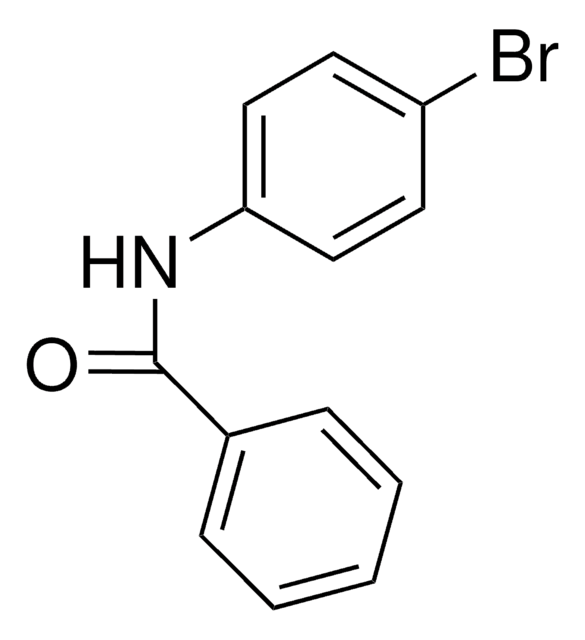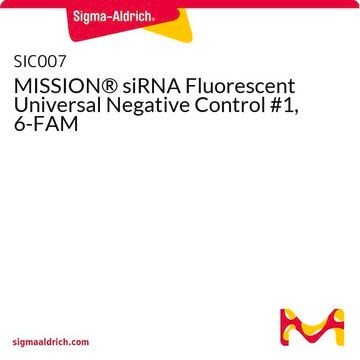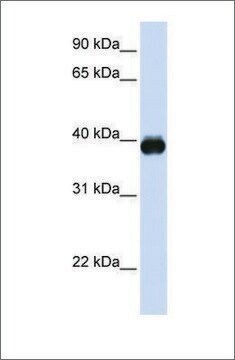NCLMIR001
MISSION® Lenti microRNA, Human
Negative Control 1
Autenticatiper visualizzare i prezzi riservati alla tua organizzazione & contrattuali
About This Item
Codice UNSPSC:
41106609
NACRES:
NA.51
Prodotti consigliati
Livello qualitativo
Nome Commerciale
MISSION®
Forma fisica
liquid
Concentrazione
≥1x106 VP/ml (via p24 assay)
Condizioni di spedizione
dry ice
Temperatura di conservazione
−70°C
Descrizione generale
Sigma′s Mission Lenti-miRs express miRNAs from a common backbone, whose structure meets requirements for accurate Dicer processing and a partially complementary strand is designed to mimic the base pairing pattern in the backbone structure using a proprietary algorithm. Oligos containing the microRNA sequences are cloned into the TRC2-pLKO-puro vector. Each miRNA construct has been cloned and sequence verified. Mature microRNA sequences are obtained from miRBase.
Lentiviral transduction particles are produced from sequence-verified lentiviral plasmid vectors. Oligos containing the microRNA sequences are cloned into the TRC2-pLKO-puro vector. Co-transfection of this vector into the appropriate cell line with compatible packaging plasmids produces viral particles that can be used to transduce mammalian cells. The polymerase II promoter, elongation factor 1 alpha (EF1A), was chosen to drive miRNA expression needed for reverse transcription of viral RNA and integration of viral DNA into the host cell genome. Additionally, the Woodchuck Hepatitis Post-Transcriptional Regulatory element allowing for enhanced expression of transgenes delivered by lentiviral vectors. This lentiviral vector also carries a puromycin resistance gene for selection of cells. Unlike murine-based MMLV or MSCV retroviral systems, lentiviral-based particles permit efficient infection and integration of the specific miRNA construct into differentiated and non-dividing cells, such as neurons and dendritic cells.
Lentiviral transduction particles are produced from sequence-verified lentiviral plasmid vectors. Oligos containing the microRNA sequences are cloned into the TRC2-pLKO-puro vector. Co-transfection of this vector into the appropriate cell line with compatible packaging plasmids produces viral particles that can be used to transduce mammalian cells. The polymerase II promoter, elongation factor 1 alpha (EF1A), was chosen to drive miRNA expression needed for reverse transcription of viral RNA and integration of viral DNA into the host cell genome. Additionally, the Woodchuck Hepatitis Post-Transcriptional Regulatory element allowing for enhanced expression of transgenes delivered by lentiviral vectors. This lentiviral vector also carries a puromycin resistance gene for selection of cells. Unlike murine-based MMLV or MSCV retroviral systems, lentiviral-based particles permit efficient infection and integration of the specific miRNA construct into differentiated and non-dividing cells, such as neurons and dendritic cells.
Prodotti consigliati
Two negative controls are available: NCLMIR001 and NCLMIR002
Note legali
MISSION is a registered trademark of Merck KGaA, Darmstadt, Germany
Codice della classe di stoccaggio
12 - Non Combustible Liquids
Classe di pericolosità dell'acqua (WGK)
WGK 3
Punto d’infiammabilità (°F)
Not applicable
Punto d’infiammabilità (°C)
Not applicable
Certificati d'analisi (COA)
Cerca il Certificati d'analisi (COA) digitando il numero di lotto/batch corrispondente. I numeri di lotto o di batch sono stampati sull'etichetta dei prodotti dopo la parola ‘Lotto’ o ‘Batch’.
Possiedi già questo prodotto?
I documenti relativi ai prodotti acquistati recentemente sono disponibili nell’Archivio dei documenti.
Lei Zhang et al.
Biomedicine & pharmacotherapy = Biomedecine & pharmacotherapie, 107, 424-432 (2018-08-14)
MicroRNAs (miRNAs) regulate a variety of development and physiologic processes, and play prominent roles in the initiation and progression of human cancers including hepatocellular carcinoma (HCC). MiR-23c is recently emerging as a cancer-associated miRNA, while its expression status and functional
Liang Bao et al.
Journal of biosciences, 42(4), 671-681 (2017-12-13)
Lung cancer is the leading cause of cancer-related death throughout the world. We aimed to investigate the role of a novel microRNA-876-5p and its potential molecular target bone morphogenetic protein 4 (BMP-4), in the epithelial-mesenchymal transition (EMT) of lung cancer.
Il team dei nostri ricercatori vanta grande esperienza in tutte le aree della ricerca quali Life Science, scienza dei materiali, sintesi chimica, cromatografia, discipline analitiche, ecc..
Contatta l'Assistenza Tecnica.








